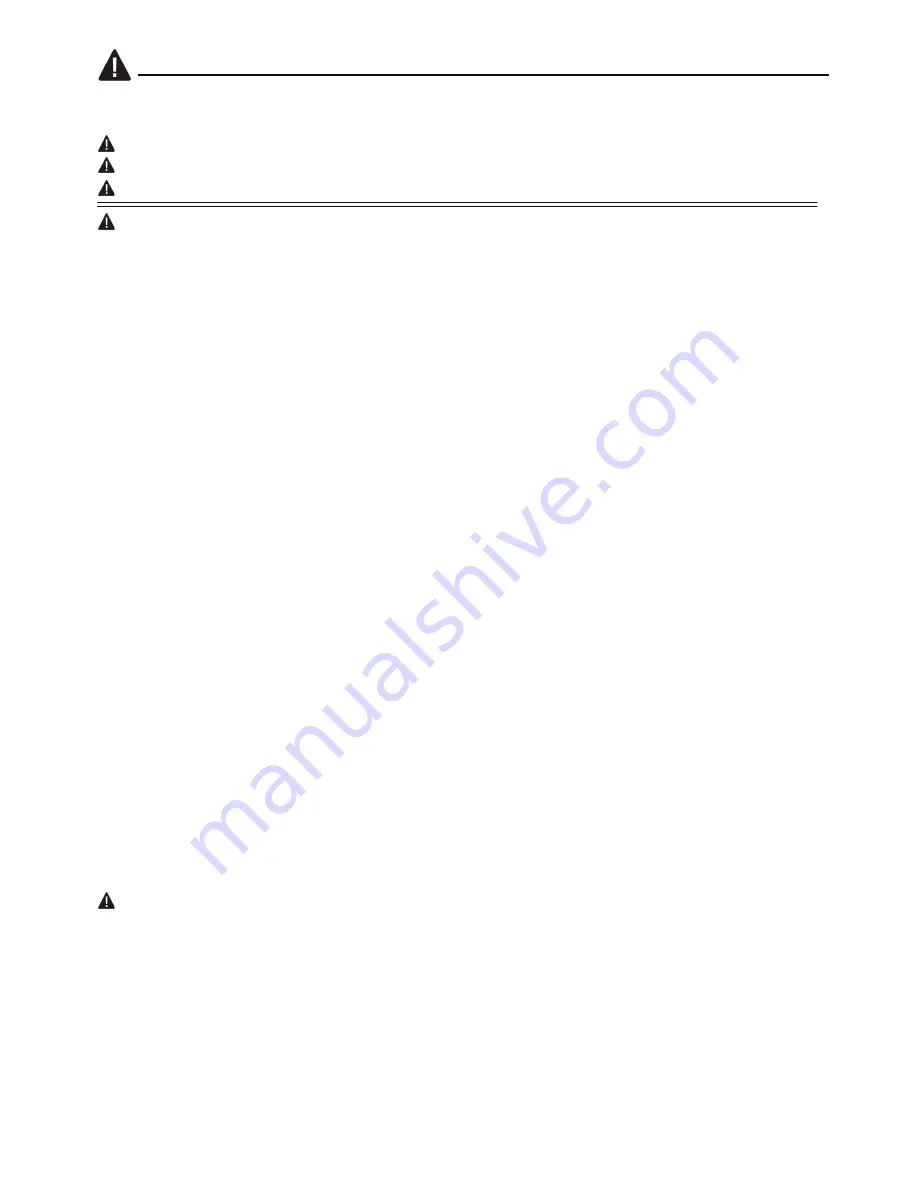
5
SAFETY INFORMATION
This manual contains information that relates to
PROTECTING YOUR SAFETY
and
PREVENTING EQUIPMENT
PROBLEMS
and is very important for you to know and understand. We use the symbols below to help you
recognize this information.
DANGER
-
POTENTIAL HAZARD THAT WILL RESULT IN SERIOUS INJURY OR LOSS OF LIFE
WARNING
-
POTENTIAL HAZARD THAT COULD RESULT IN SERIOUS INJURY OR LOSS OF LIFE
CAUTION
-
POTENTIAL HAZARD THAT MAY RESULT IN MODERATE INJURY OR DAMAGE TO EQUIPMENT
WARNING
1.
RISK OF EXPLOSION OR FIRE.
Never spray flammable liquids in a confined area. It is normal for
the motor and pressure switch to produce sparks while operating. If sparks come into contact with
vapors from gasoline or other solvents, they may ignite and cause a fire or explosion. Do not smoke
while spraying. Do not spray where sparks or flame are present. Keep compressor as far from
spray area as possible. Always operate the compressor in a well-ventilated area.
2.
RISK OF ELECTRIC SHOCK.
A licensed electrician in accordance with all local and national codes
must install all wiring. To avoid electric shock, NEVER use an electric air compressor outdoor when
it is raining or on a wet surface.
3.
RISK OF BURSTING.
Rust can weaken the tank. Drain the condensed water from the tank after
each use to reduce rusting. DO NOT weld, drill or modify the air tank of this compressor. Welding or
modifications on the air tank can severely impair tank strength and cause an extremely hazardous
condition. If a leak is detected in the tank, replace the tank right away.
4.
RISK OF INJURY.
ALWAYS shut off the compressor, remove the plug from the outlet and bleed all
pressure from the system before servicing the compressor or when the compressor is not in use.
Do NOT use the unit with the shrouds removed. Contact with moving parts could cause serious injury.
5.
RISK OF BURSTING.
Check the maximum pressure rating in the manual or the serial tag label.
Compressor outlet pressure must be regulated so as to never exceed the maximum pressure rating.
Relieve all pressure through the hose before removing or attaching accessories.
6.
RISK OF BURSTING.
DO NOT adjust the pressure switch or relief valve for any reason. They have
been preset at the factory for the maximum pressure of this unit. If the pressure switch or the relief
valve are tampered with, personal injury or property damage may occur.
7.
RISK OF BURNS.
Pump and manifold generate high temperature. To avoid burns or other injuries,
DO NOT touch the pump, manifold or transfer tube while the unit is running. Allow the parts to cool
before handling or servicing. Keep children away from the compressor at all times.
8.
RISK TO BREATHING.
Be certain to read all labels when you are spraying paints or toxic materials,
and follow the safety instructions. Use a respirator mask if there is a chance of inhaling anything
you are spraying. NEVER directly inhale the compressed air produced by a compressor.
9.
RISK OF EYE INJURY.
ALWAYS wear ANSI Z87.1 approved safety goggles when using an air
compressor. NEVER point nozzle or sprayer toward a person or any part of the body. If the spray
penetrates the skin, serious injury may occur.
10. You can create dust when you cut, sand, drill or grind materials such as wood, paint, metal,
concrete, cement, or other masonry. This dust often contains chemicals known to cause cancer,
birth defects, or other reproductive harm.
Wear protective gear
.
CAUTION
1. Pull the pressure relief valve ring daily to ensure that the valve is functioning properly.
2. The unit must be kept a minimum of 12 inches from the nearest wall in a well-ventilated area for
cooling.
3. Protect the air hose and electric cord from damage and puncture. Inspect them weekly for weak or
worn spots and replace if necessary.
4. Always wear hearing protection when using an air compressor. Failure to do so may result in hearing
loss.
5. Operation of the unit should always be in a position that is stable. Never use the unit on a rooftop or
elevated position that could allow the unit to fall or be tipped over.






























